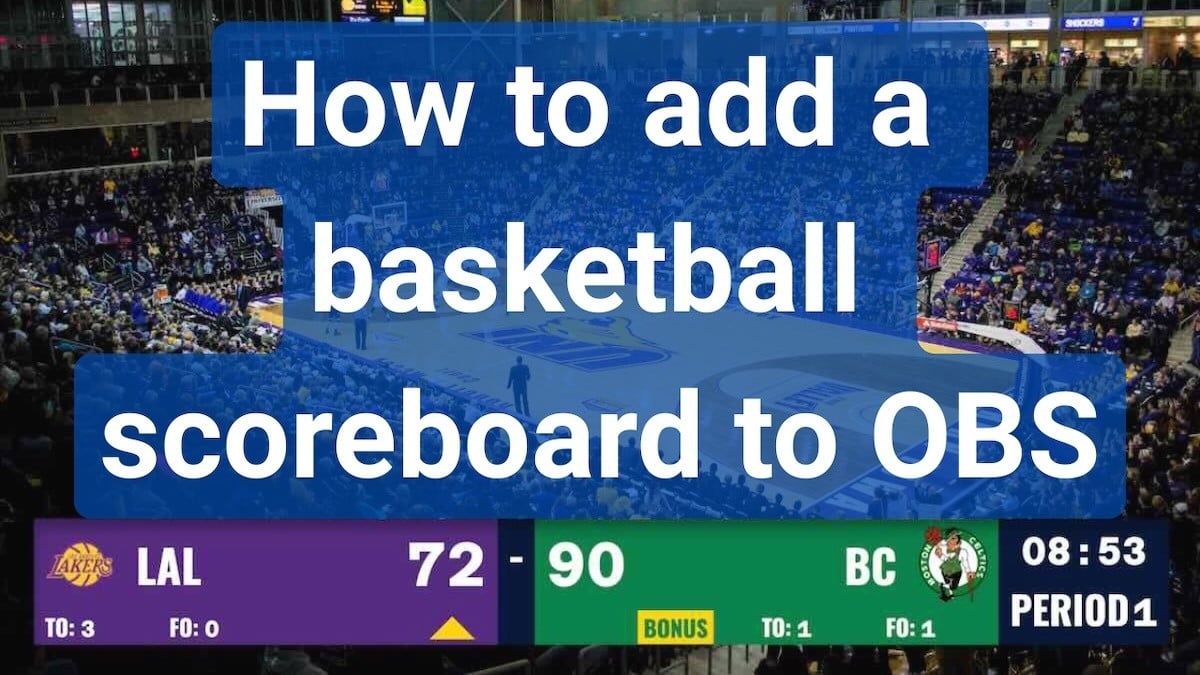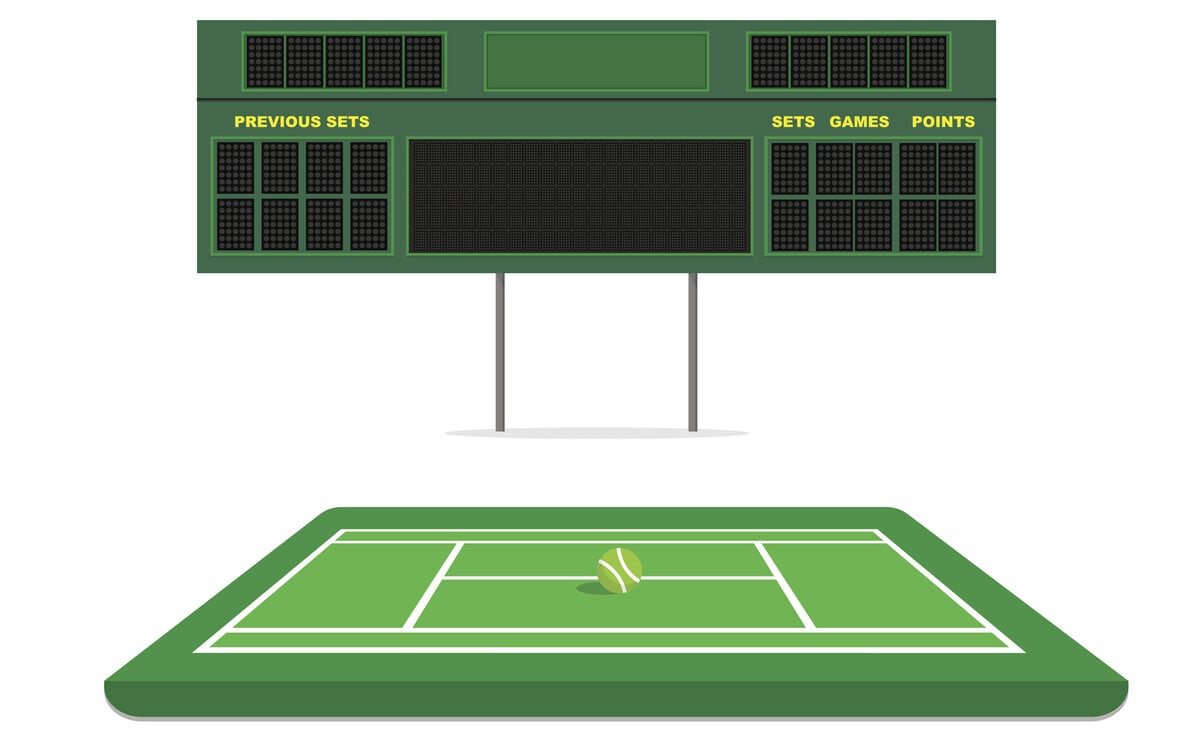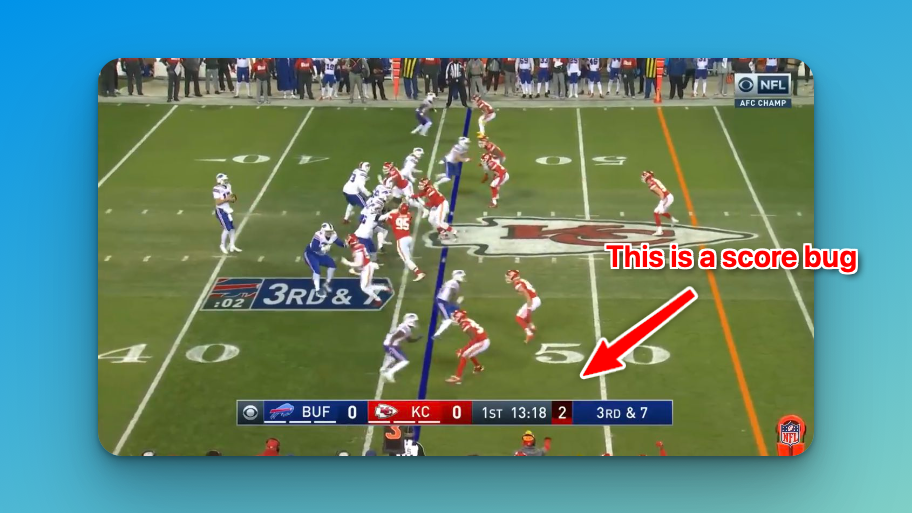
Whether you're watching your first basketball game or operating a scoreboard for your local league, understanding what all those numbers and indicators mean can be overwhelming. Modern basketball scoreboards display far more than just the score—they're information centers that track every critical aspect of the game.
This guide explains every element you'll see on a basketball scoreboard, from the basics like score and time to advanced features like possession arrows and bonus indicators. You'll learn what each display means, why it matters, and how it affects the game.
Essential Scoreboard Elements Every Fan Should Know
Basketball scoreboards share core information across all levels of play, from youth leagues to the NBA. These fundamental elements form the backbone of game tracking and are essential for following the action.
The Score Display
The most prominent feature on any scoreboard is the current point total for each team. Displayed in large, bright digits visible from anywhere in the arena, the score updates instantly after each basket. Traditional placement shows the home team on the right or bottom, though modern digital displays sometimes allow customization.
Points accumulate throughout the game without resetting between periods. Understanding how basketball scoring works—with field goals worth 2 or 3 points and free throws worth 1 point—helps you anticipate score changes as plays develop.
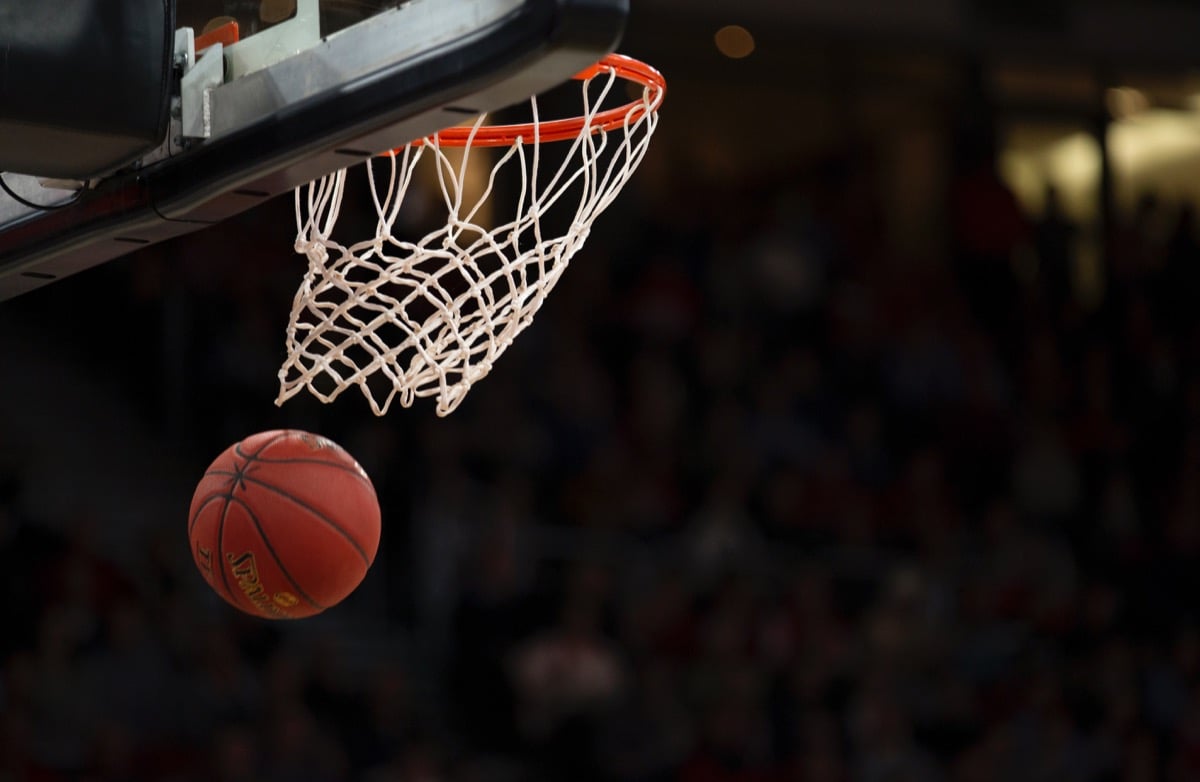
Game Clock: Managing Time
The game clock counts down the remaining time in the current period. Different levels of basketball use different period structures:
- NBA: Four 12-minute quarters (48 minutes total)
- WNBA: Four 10-minute quarters (40 minutes total)
- NCAA Men's: Two 20-minute halves (40 minutes total)
- NCAA Women's: Four 10-minute quarters (40 minutes total)
- FIBA International: Four 10-minute quarters (40 minutes total)
- High School: Four 8-minute quarters (32 minutes total)
The clock stops for various reasons including timeouts, fouls, out-of-bounds plays (in the final minutes), and free throws. This stoppage is why actual game duration typically extends to 2-2.5 hours despite the shorter game clock time.
Period/Quarter Indicator
This display shows which segment of the game is currently being played. Most scoreboards show:
- Numbers 1-4 for quarters
- Numbers 1-2 for halves (college men's basketball)
- "OT" for overtime periods (sometimes numbered for multiple overtimes)
Some advanced scoreboards also display the time between periods, counting down intermission breaks.
Team Fouls: Tracking Penalties
Team fouls accumulate throughout each period and reset at the start of a new quarter or half. This count is crucial because reaching certain foul thresholds triggers "bonus" free throw situations for the opposing team.
The display typically shows a simple number for each team, sometimes with warning lights or colors when approaching bonus thresholds. In youth basketball, some scoreboards also track individual player fouls to help coaches manage playing time and avoid disqualifications.
Timeouts Remaining
Each team receives a limited number of timeouts per game to stop play for strategic discussions. The timeout allocation varies by level:
- NBA: 7 timeouts per game (with usage restrictions by half)
- NCAA: 4 timeouts per game plus one 30-second timeout per half
- High School: 5 timeouts per game (3 full, 2 thirty-second)
Scoreboards display remaining timeouts as simple numbers or dots/lights for each team. Calling more timeouts than allowed results in a technical foul.
Advanced Scoreboard Features That Impact Strategy
Beyond basic information, modern scoreboards include specialized displays that directly influence game strategy and rules enforcement.
Shot Clock: The Pace Controller
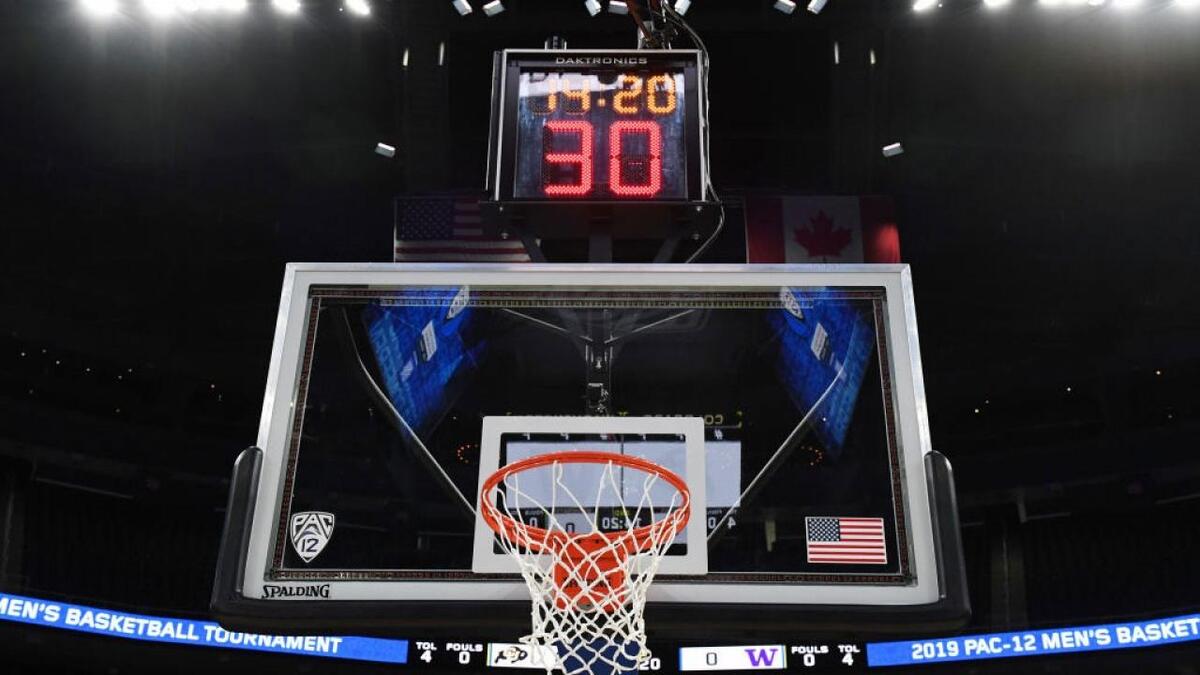
The shot clock revolutionized basketball by forcing teams to attempt shots within a time limit, preventing stalling tactics. Introduced to the NBA in 1954, it transformed basketball from a slow, deliberate game into the fast-paced sport we know today.
The shot clock display shows seconds remaining for the offensive team to attempt a shot that hits the rim. Typically mounted above each basket for player visibility, these bright red numbers count down relentlessly, creating urgency and excitement:
Shot Clock Duration by League:
- NBA: 24 seconds
- WNBA: 24 seconds
- NCAA Men's and Women's: 30 seconds
- FIBA International: 24 seconds
- High School: 35 seconds (where used; not universal)
Reset Rules:
- Full reset after defensive team gains possession
- NBA: Resets to 14 seconds after offensive rebound
- NCAA: Resets to 20 seconds after offensive rebound
- Resets to full time if foul occurs with more time on shot clock than reset value
The shot clock display typically sits above the backboard for player visibility, with duplicate displays on the main scoreboard. Most modern arenas use LED displays visible from any angle, with some featuring countdown sounds in the final seconds.
Shot Clock Violations:
When the shot clock expires without a shot attempt hitting the rim, it's called a "shot clock violation" or "24-second violation" (NBA). The result: * Immediate turnover to the opposing team * No points awarded * Opposing team inbounds from the sideline * Often accompanied by a distinct buzzer sound
Coaches and players constantly monitor the shot clock, often calling plays specifically designed for "late clock" situations when time is running out.
Bonus Indicators: Free Throw Situations
Bonus indicators signal when a team has committed enough fouls to trigger automatic free throws for non-shooting fouls. These displays show as "BONUS" text, illuminated lights, or colored indicators next to team names.
Bonus Thresholds:
- NBA:
- Team enters bonus after opponent's 4th team foul per quarter
-
All non-shooting fouls result in two free throw attempts
-
NCAA:
- "One-and-One" bonus after opponent's 7th foul per half
-
"Double Bonus" after opponent's 10th foul (automatic two shots)
-
FIBA/International:
- Bonus after opponent's 4th foul per quarter
-
Two free throws for all subsequent non-shooting fouls
-
High School:
- One-and-one after opponent's 7th foul per half
- Double bonus after 10th foul
Understanding bonus situations helps explain why players sometimes receive free throws even when not shooting, a common source of confusion for new fans.
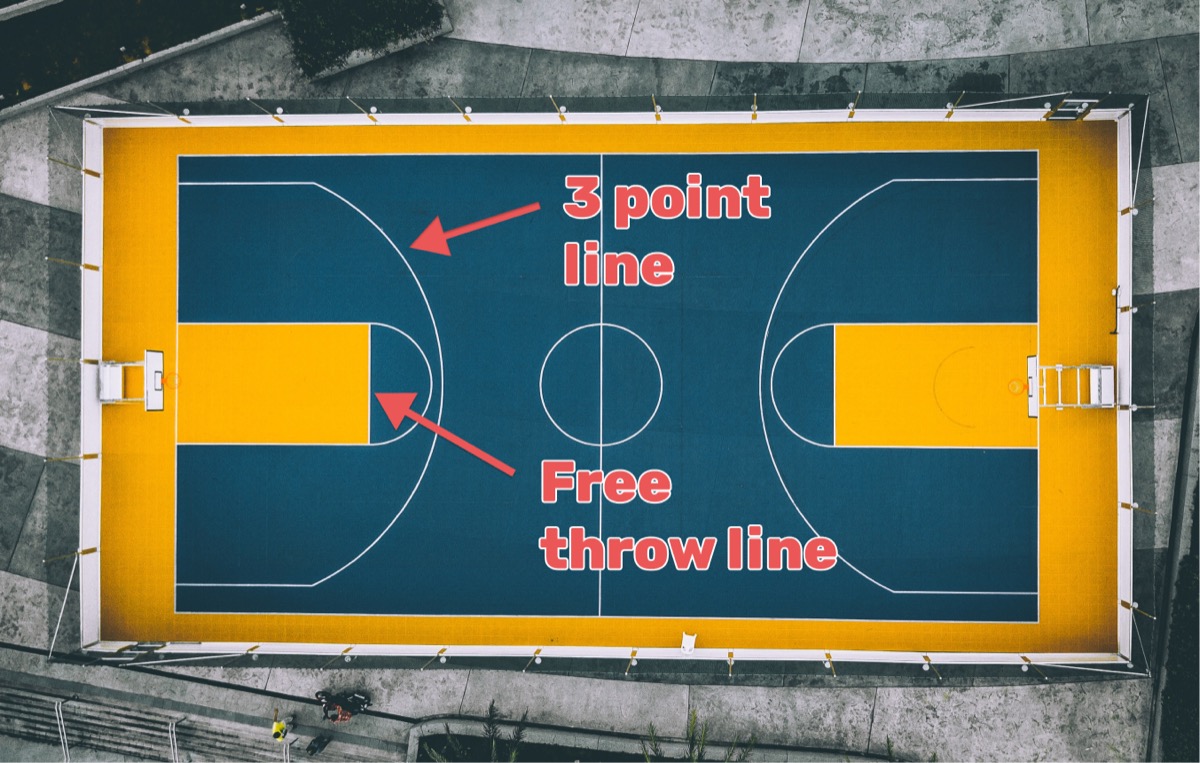
The free-throw line shown above becomes especially important during bonus situations, as non-shooting fouls can result in multiple trips to this spot.
Possession Arrow (College and High School)
The possession arrow replaces jump balls in many basketball leagues. After the opening tip-off, subsequent jump ball situations award possession based on the arrow's direction, which alternates after each use.
The scoreboard displays an arrow or indicator showing which team receives the ball next in a jump ball situation. Common jump ball scenarios include:
- Two players simultaneously gaining possession
- Ball getting lodged between rim and backboard
- Officials uncertain about last touch before out-of-bounds
- Double fouls with no clear possession
The NBA still uses actual jump balls for these situations, making the possession arrow unique to amateur basketball.
Specialized Display Information
Modern digital scoreboards, especially in professional arenas, include additional information enhancing the fan experience:
Player-Specific Information
Advanced scoreboards can display:
- Current lineup: Jersey numbers of players currently on court
- Individual statistics: Points, fouls, rebounds for key players
- Foul trouble warnings: Highlighting players with 4+ fouls
- Substitution notifications: Showing who's entering and leaving
Team Statistics
Professional and college scoreboards often show:
- Shooting percentages: Field goal and three-point percentages
- Team rebounds: Total rebounds for each team
- Turnovers: Possession losses for each team
- Fast break points: Points scored in transition
- Points in the paint: Scores from close range
Game Management Displays
- Review indicators: When officials are reviewing plays via replay
- Challenge status: In NBA, showing if teams have used their coach's challenge
- Technical foul indicators: Special notation for technical or flagrant fouls
- Warning notifications: For delay of game or other warnings
Reading Scoreboards Across Different Venues
Scoreboard configurations vary significantly based on venue and level of play:
Professional Arena Scoreboards
NBA and WNBA arenas feature massive center-hung video boards with:
- 360-degree viewing angles
- HD video replay capability
- Real-time statistics integration
- Sponsor advertisements between game information
- Entertainment features during timeouts
College Scoreboards
University scoreboards range from basic LED displays to professional-grade video boards, typically including:
- Shot clock and game clock synchronization
- Conference-specific bonus rules display
- Band and student section cams
- Academic achievement highlights
High School and Youth League Scoreboards
Community gym scoreboards focus on essentials:
- Score, time, period, and fouls
- Manual or basic electronic operation
- Portable options for multi-use facilities
- Simple horn/buzzer systems
Recreational and Practice Facilities
Basic scoreboards for casual play might only show:
- Running score (sometimes manual flip cards)
- Basic timer or no clock
- Simple foul tracking
How Scoreboards Reflect Game Flow

Understanding scoreboard information helps you follow game momentum and strategic decisions:
Clock Management: Teams trailing late in games use fouls and timeouts strategically, visible through foul counts and timeout displays.
Bonus Exploitation: Teams may attack aggressively when opponents are in foul trouble, knowing that any foul yields free throws.
Shot Clock Pressure: The dwindling shot clock forces quick decisions, often resulting in lower-percentage shots as time expires.
Substitution Patterns: Foul counts influence when coaches rest key players, especially visible in the scoreboard's individual foul tracking.
Digital Scorekeeping Solutions for Modern Basketball
For leagues and venues seeking modern scoreboard solutions, KeepTheScore's basketball scoreboard provides comprehensive digital displays accessible from any device. Features include shot clock management, bonus indicators, and mobile control for seamless game operations.
Streaming your games? Learn how to add a basketball scoreboard overlay to OBS for professional broadcasts.
Mastering Scoreboard Literacy
Understanding basketball scoreboards transforms your viewing experience from passive watching to active engagement. Whether you're a parent at youth games, a fan at professional matches, or an aspiring scorekeeper, recognizing these displays helps you appreciate the game's strategic depth.
Next time you watch basketball, challenge yourself to predict plays based on scoreboard information. Notice how teams change tactics when entering bonus situations, or how shot clock pressure affects offensive decisions. This deeper understanding enriches your basketball experience, whether courtside or streaming from home.
For more basketball insights, explore how basketball scoring works to understand the points system behind those changing numbers on the scoreboard.
